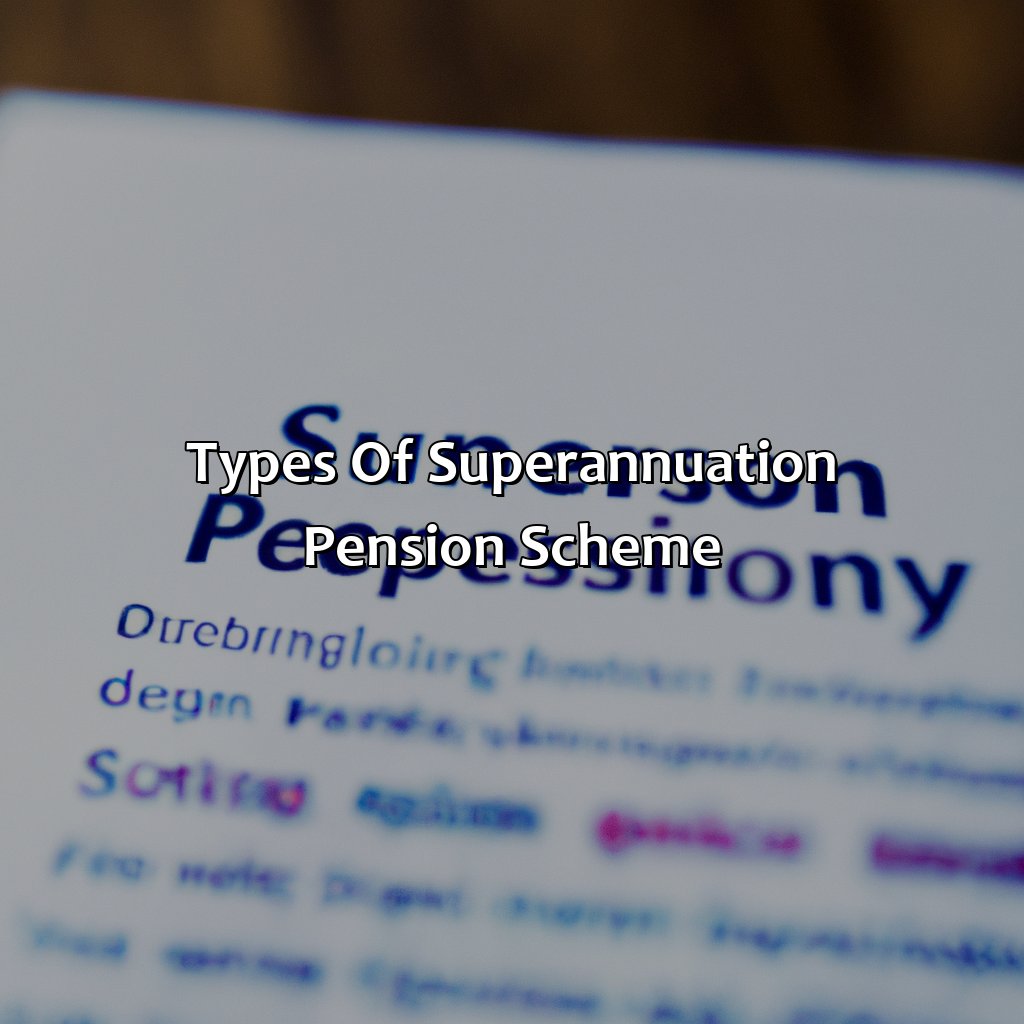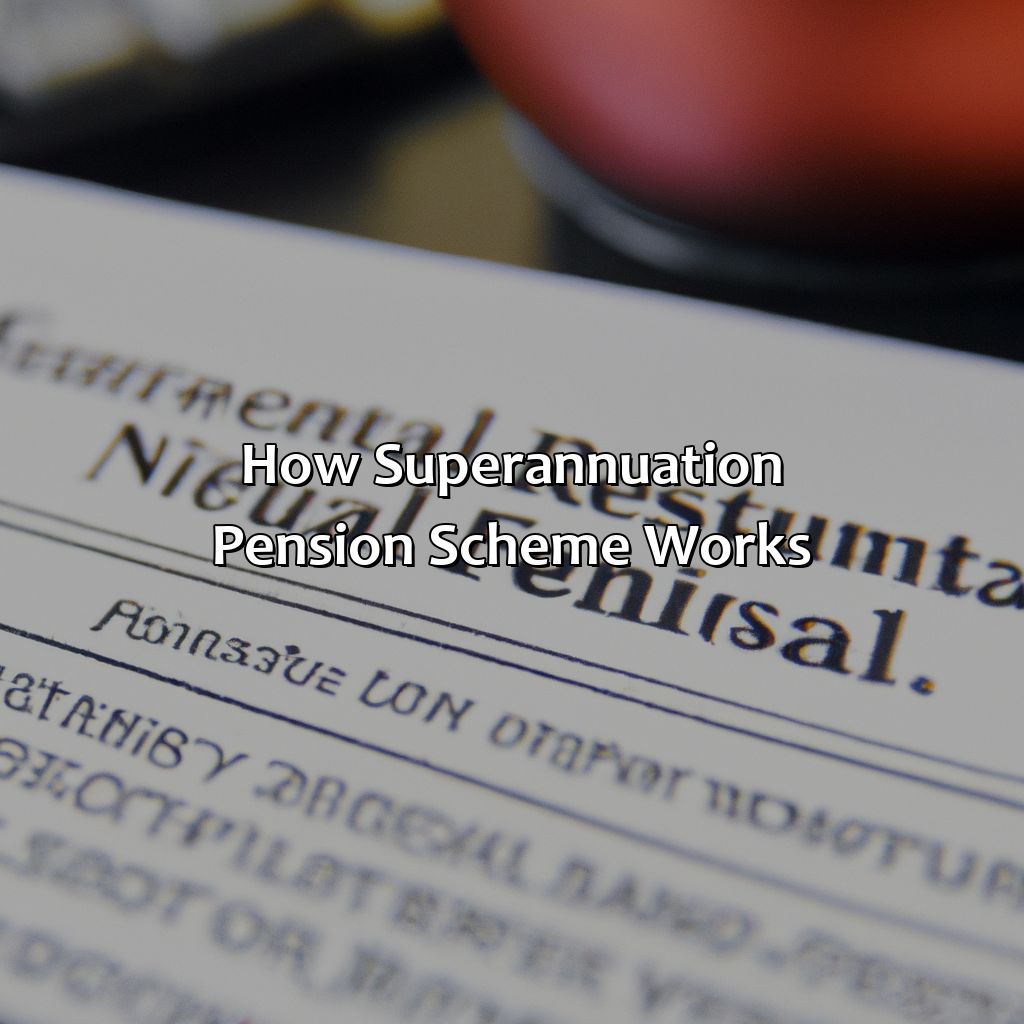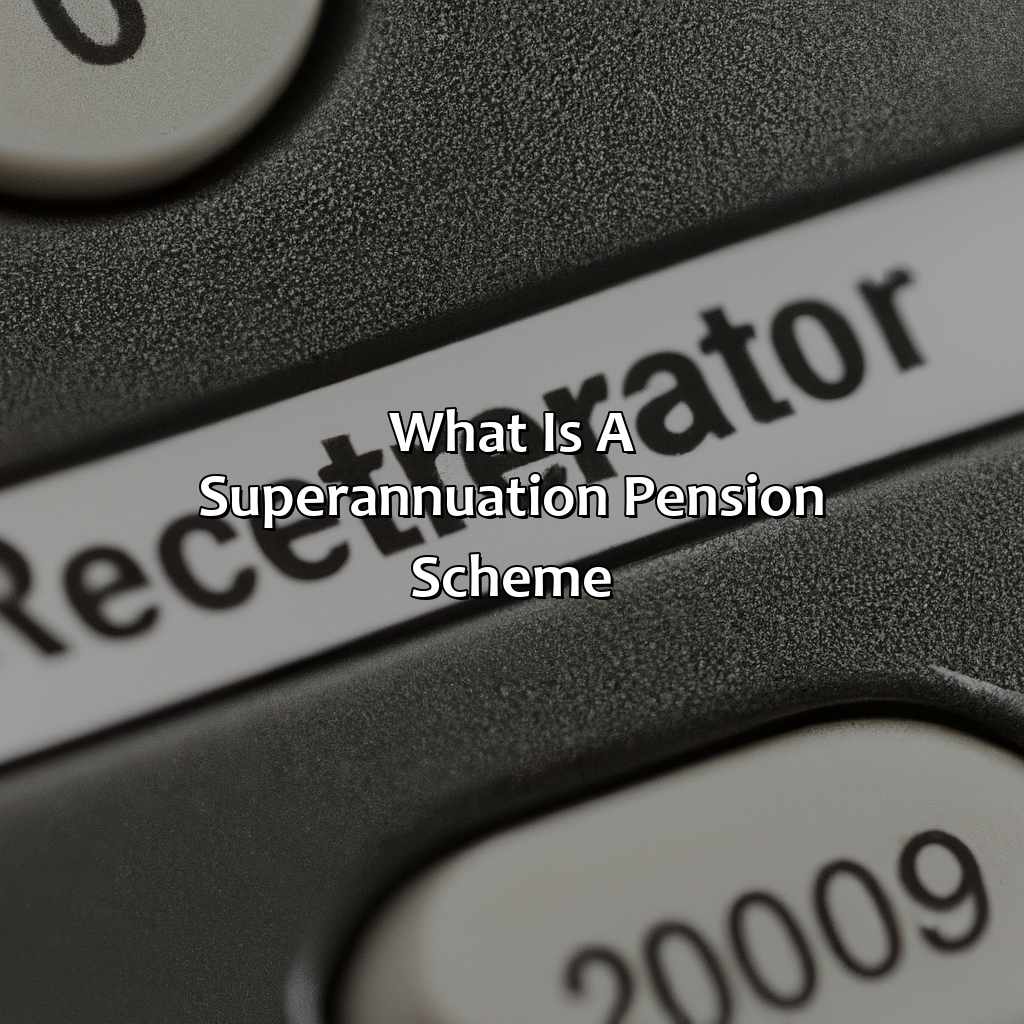What Is A Superannuation Pension Scheme?
Key Takeaway:
- A superannuation pension scheme is a retirement savings plan that provides long-term financial security to individuals through a combination of employer and employee contributions.
- There are various types of superannuation pension schemes, including defined benefit, defined contribution, and self-managed super funds, each with their own features and benefits.
- One of the key benefits of a superannuation pension scheme is the tax benefits that it offers, which can have a significant impact on an individual’s retirement savings. Additionally, these schemes provide long-term financial security and peace of mind, making them an important aspect of retirement planning.
Are you confused about superannuation pension schemes? Look no further! In this article, we’ll explain everything you need to know so you can make the most of your retirement. You’ll gain a better understanding of how superannuation works and what it can do for you.
What is a Superannuation Pension Scheme?
Gain insight into a superannuation pension scheme. Discover its definition and features. This will give you more knowledge on how it functions and identify its perks. It is vital to comprehend the definition and features of a superannuation pension scheme for making judgements on retirement planning that are well-informed.

Image credits: retiregenz.com by David Arnold
Definition of Superannuation Pension Scheme
Superannuation pension scheme refers to a retirement savings plan set up by employers for their employees. It is designed to accumulate funds over an extended period, which are used to provide regular payments during retirement. These schemes are mandatory in some countries and offer tax benefits to both employees and employers. Superannuation funds are invested in various assets such as stocks, bonds, real estate, etc., and the accumulated amount depends on the performance of these assets.
The contributions made by employees usually come from their pre-tax salary, while employers may also make additional contributions on behalf of each employee. There are different types of superannuation pension schemes available worldwide, including defined benefit plans and defined contribution plans. Defined benefit plans guarantee a fixed income level upon retirement based on length of service, age or salary level, while defined contribution plans depend on contributions and investment returns during an individual’s working life.
It is important for individuals to monitor their superannuation balances regularly and review their investment strategies periodically to ensure maximum returns upon retirement. Not doing so could lead to inadequate funds during retirement or even significant losses if investments perform poorly.
In Australia, the history of superannuation pension schemes dates back to the early 1900s when public sector workers started receiving mandatory employer contributions towards a retirement savings fund known as a super scheme. Over time, this practice spread across different industries until it became mandatory for all organizations with employees in Australia.
Don’t worry about retirement, just Superannuate and chill – your pension scheme has got your back!
Features of Superannuation Pension Scheme
Superannuation Pension Scheme refers to a retirement investment plan that is contributed by both the employer and employee to provide financial support after retirement. The scheme provides several unique features that help individuals save for their future.
- The superannuation pension scheme has a locked-in investment feature, which means the money cannot be withdrawn before retirement.
- It is not taxed until the individual withdraws it at the time of retirement.
- Employers generally contribute a certain percentage of the employee’s salary towards this scheme.
- The fund can be invested in different types of assets, including stocks, bonds, and property.
- It offers low tax rates when withdrawing money from the scheme during retirement.
- The superannuation pension scheme also offers life insurance and total and permanent disability insurance.
The scheme also allows for personal contributions in addition to those made by employers. However, there are specific rules governing claiming and withdrawing funds, which should be understood by contributors.
A notable fact is that Australia’s superannuation system is one of the world’s largest private retirement savings systems.
If you are wondering about retirement plans, you may have heard the term deferred pension. It is a type of pension plan that allows individuals to delay receiving pension payments until a later date. This can be a useful option for those who wish to continue working or have other sources of income during their retirement years.
Get ready to choose your superannuation pension scheme like a kid in a candy store, but with a lot more adult responsibility and a lot less cavity-inducing sweetness.
Types of Superannuation Pension Scheme
To understand the different types of superannuation pension schemes, you need to know which one suits your retirement needs. Options include:
- a defined benefit scheme,
- a defined contribution scheme,
- and a self-managed super fund.
In this section, explore each type. This will help you make an informed decision about your superannuation pension scheme.

Image credits: retiregenz.com by Harry Arnold
Defined Benefit Scheme
A type of superannuation pension scheme that provides retirement benefits based on a formula that takes into account the employee’s salary and length of service. The benefits of this scheme are predetermined, unlike other schemes where benefits depend on investment returns. The employer is responsible for funding the scheme, making it a valuable employee benefit.
This type of pension often requires the mandatory contribution of employees and employers. Employees earn defined benefits based on their salary and years worked, regardless of market performance. The investment risk is borne by the employer rather than the employee. If you want to know more about this type of pension, you can check out the state second pension scheme.
It’s important to note that multiple factors impact defined benefits, such as accrual rates, vesting periods and benefit scales depending on years worked. Additionally, many countries have unique tax regulations around these schemes.
A recent report from the pension funds revealed that 120 multiemployer programs covering over 1 million people face severe financial difficulties in paying promised pensions due to unfunded liabilities resulting from historical underfunding by employers.
One example was with automaker General Motors who faced bankruptcy in 2008. At this time, they had an estimated $134 billion in unfunded pension obligations which made restructuring negotiations complex due to balancing payments owed to retirees while simultaneously financing present operations amidst an economic downturn.
Defined contribution schemes: where the only thing certain about your retirement is uncertainty.
Defined Contribution Scheme
A Defined Contribution Scheme is a type of superannuation pension plan where the contributions are fixed but the benefits depend on factors like investment returns and market fluctuations. Employers and employees make contributions to the fund, which is managed by an investment manager who invests it in a variety of assets.
The amount you receive as a lump sum or regular income upon retirement depends on how much you have accumulated over time through your contributions and investment returns. If you are wondering how does Ibew pension work then it’s important to understand that it is a type of superannuation pension scheme.
It’s important to note that unlike other types of superannuation funds, where the payouts are fixed based on factors like years of service and final salary, the payouts in defined contribution schemes can be unpredictable because they rely heavily on market performance. This means that while defined contribution plans offer flexibility and portability, they also come with more risk.
With our increasing life expectancy, saving for retirement has become more crucial than ever before. To ensure a comfortable life post-retirement, it’s essential to start planning early and stay committed throughout your working life. It’s never too late to take charge of your financial future, so don’t miss out on opportunities to save for retirement through various superannuation schemes available in the market today.
If you’re going through a divorce or separation, you might also want to learn about pension sharing orders and how they can affect your retirement income.
Managing your own super fund may sound daunting, but hey, at least you get to be your own boss…of money.
Self-Managed Super Fund
One type of superannuation pension scheme is the option for individuals to manage their own retirement fund. This personalized approach is known as a participant-controlled plan, requiring investors to make decisions regarding contributions and investment options. Utilizing this plan requires financial knowledge and organizational skills, as well as ongoing maintenance and accountability to ensure compliance with regulations. Centralized record keeping may assist in ease of management while providing logistical support and guidance on compliance requirements.
A self-managed option allows investors greater control over their retirements funds with little interference from third-party organizations but also requires strict adherence to IRS restrictions such as sufficiently aged assets for distribution, so financial consulting is available.
It’s worth noting that this type of superannuation plan has both advantages and disadvantages, such as potentially lower fees than traditional structured plans but requiring extensive knowledge and discipline. Researching all options before making a decision is advised.
Pro Tip: Before moving on a self-managed superannuation fund, you should reconcile whether it makes sense financially based on your circumstances and retirement goals. Why work hard now when you can work smart with a superannuation pension scheme?
How Superannuation Pension Scheme Works
Understand the superannuation pension scheme? First, grasp accumulation and retirement phases. They’re the answers. The accumulation phase involves saving and investing for retirement. The retirement phase means you can withdraw your saved funds as pension income.

Image credits: retiregenz.com by James Washington
Accumulation Phase
During the phase where an individual is contributing to their superannuation pension, funds are accumulated and invested. This accumulation phase goes on until the person reaches retirement age or decides to withdraw their savings. Contributions can come from both employers and employees, with employee contributions being made pre-tax. The accumulated funds are invested in a range of assets such as shares, property, and fixed interest securities to generate returns over time. The investment returns along with the contributions made determine the final retirement benefit value.
It’s important to note that during this phase, the choice of investment assets and fund options may vary depending on the individual’s risk appetite and financial circumstances. Regular reviews of investments should be carried out to ensure they align with changing circumstances.
Pro Tip: It’s a good idea to plan for upcoming changes in life circumstances such as marriage, having children or changing jobs as these events can impact your future superannuation savings significantly.
Retirement: the time when you trade in your suits for sweatpants and your alarm clock for a pension scheme.
Retirement Phase
As an important phase of the superannuation pension scheme, the period when an individual retires can significantly influence their ongoing financial stability and security. During this time, they can choose to receive regular payments from their accumulated superannuation fund, enabling them to manage their expenses and maintain an appropriate standard of living. This phase is critical for individuals to use their funds wisely as any improper usage may lead to insufficient financial support in later years.
It is essential for retirees in this phase to have a sound understanding of the options available under the scheme. They can opt for income streams with varying features and payment frequencies, depending on their personal requirements. The benefits available during retirement will also rely on the amount accumulated in the superannuation fund throughout one’s working life and government regulations at that point in time.
If you are wondering what is a serp pension, it is a superannuation pension scheme that offers retirees various income stream options based on their personal requirements. The benefits available during retirement will completely depend on the amount accumulated in the fund throughout one’s working life and government regulations at that point in time.
Retirement Phase plays a significant role in determining the quality of life that individuals would experience after having retired. Some elderly people avail pensions lesser than what they had expected due to poor management decisions made during this stage. Henceforth, it is advisable for such cases to analyze before investing and take professional advice if required.
Consider Cathy who entered Retirement Phase two years ago but failed in managing her superannuation fund effectively. She opted for lump-sum payments instead of income streams and started spending it unwisely which drastically effected her savings after a few months, leaving her with reduced monetary transactions during the Retirement Phase. A better understanding could’ve helped Cathy maximize her savings, ensuring she enjoyed her pension comfortably without cutting back too much on necessary expenses.
To avoid such situations, it is important to have a clear understanding of different types of pension schemes like Single Life Annuity Pension and Superannuation Pension Scheme.
Stick with a superannuation pension scheme and you’ll be retiring like a boss, minus the yacht and private island.
Benefits of Superannuation Pension Scheme
Understand the perks of Superannuation Pension Scheme! Tax Benefits and Long-Term Financial Security could be solutions. These sub-sections give impressive advantages to make the most of your retirement funds. For example, tax liability can be minimized. Plus, long-term financial planning and future retirement stability can be ensured. Let’s dive in and explore these sub-sections in detail and reap the benefits of Superannuation Pension Scheme.

Image credits: retiregenz.com by James Jones
Tax Benefits
Superannuation pension schemes offer advantageous tax benefits to individuals. These pension schemes allow individuals to contribute pre-tax income towards their retirement savings, thereby reducing their taxable income. Additionally, these contributions and the earnings on them are taxed at a lower rate compared to regular employee income.
These tax benefits are not limited to just the contribution phase of the scheme. The distribution of funds during retirement is also considered as taxable income, but even then superannuation pensions attract lower taxes compared to other sources of income. This results in significant long-term savings for investors.
Moreover, some employers offer contribution matching or salary sacrificing options that provide additional tax benefits. These can be leveraged optimally by seeking professional guidance from financial advisors.
Investing in a pension scheme not only saves money but also fosters a disciplined approach towards long-term wealth accumulation. In turn, this ensures adequate retirement funding and a comfortable lifestyle post-retirement.
Retirement planning is like a marathon, except the finish line keeps moving – thank goodness for superannuation!
Long-Term Financial Security
Achieving long-term financial stability and security is a crucial aspect of individual financial planning. One way to achieve this is through investing in a superannuation pension scheme. This type of scheme allows individuals to make regular contributions towards their retirement savings, ensuring they have a steady income source to rely on once they retire.
A superannuation pension scheme offers several benefits, such as:
- flexibility in investment options
- tax advantages
- the ability to access professional funds management services
- Additionally, many employers offer matching contributions to their employees’ superannuation accounts, which helps boost their retirement savings even further.
It’s important to note that a frozen pension plan isn’t a one-size-fits-all approach. There are different types of schemes available, each with its own set of rules and regulations. It’s essential for individuals to understand these rules thoroughly and seek professional advice if necessary.
In the past, relying solely on government pensions was common practice for retirees in Australia. However, increasing life expectancies and the rising cost of living means this may no longer be feasible for all individuals seeking long-term financial security. As such, investing in a money purchase pension plan can provide an additional income stream during retirement years.
Five Facts About Superannuation Pension Scheme:
- ✅ A superannuation pension scheme is an investment vehicle designed to provide income in retirement. (Source: ASIC’s MoneySmart)
- ✅ Employers are required by law to contribute a percentage of an employee’s salary to their superannuation account. (Source: ATO)
- ✅ Superannuation funds offer a range of investment options, including stocks, bonds, and property investments. (Source: SuperGuide)
- ✅ Australians are eligible to access their superannuation savings when they reach a certain age or meet certain criteria, such as hardship or permanent disability. (Source: Australian Government)
- ✅ Superannuation pension schemes offer tax benefits and incentives to encourage retirement savings. (Source: Moneysmart)
FAQs about What Is A Superannuation Pension Scheme?
What is a superannuation pension scheme?
A superannuation pension scheme is a retirement savings plan where an individual contributes a portion of their income regularly into a fund, which is then managed by a trustee. The accumulated funds are then used to provide a steady income throughout the individual’s retirement years.
How does a superannuation pension scheme work?
An individual contributes a percentage of their income into a superannuation fund. The funds are then invested in various assets such as stocks, property and cash, to generate returns. When the individual reaches their retirement age, they can either withdraw the accumulated funds as a lump sum or receive regular payments in the form of a pension.
What are the benefits of a superannuation pension scheme?
A superannuation pension scheme provides a reliable source of income during retirement. The funds are also invested in various assets, providing the potential for growth and higher returns. Additionally, contributions made into a superannuation fund are taxed at a lower rate than regular income, making it an attractive option for retirement savings.
Is a superannuation pension scheme compulsory?
Yes, in most countries, including Australia, a superannuation pension scheme is compulsory for employees. Employers are required to contribute a percentage of their employee’s salary into a superannuation fund, which is then managed by the employee.
Can I choose my own superannuation fund?
Yes, individuals can choose their own superannuation fund. It is important to research and compare different superannuation funds to ensure they meet your needs and investment goals.
What happens to my superannuation pension scheme if I die?
If an individual with a superannuation pension scheme passes away, the remaining funds are passed on to their beneficiary. The beneficiary can choose to receive the funds as a lump sum or continue to receive regular pension payments.


